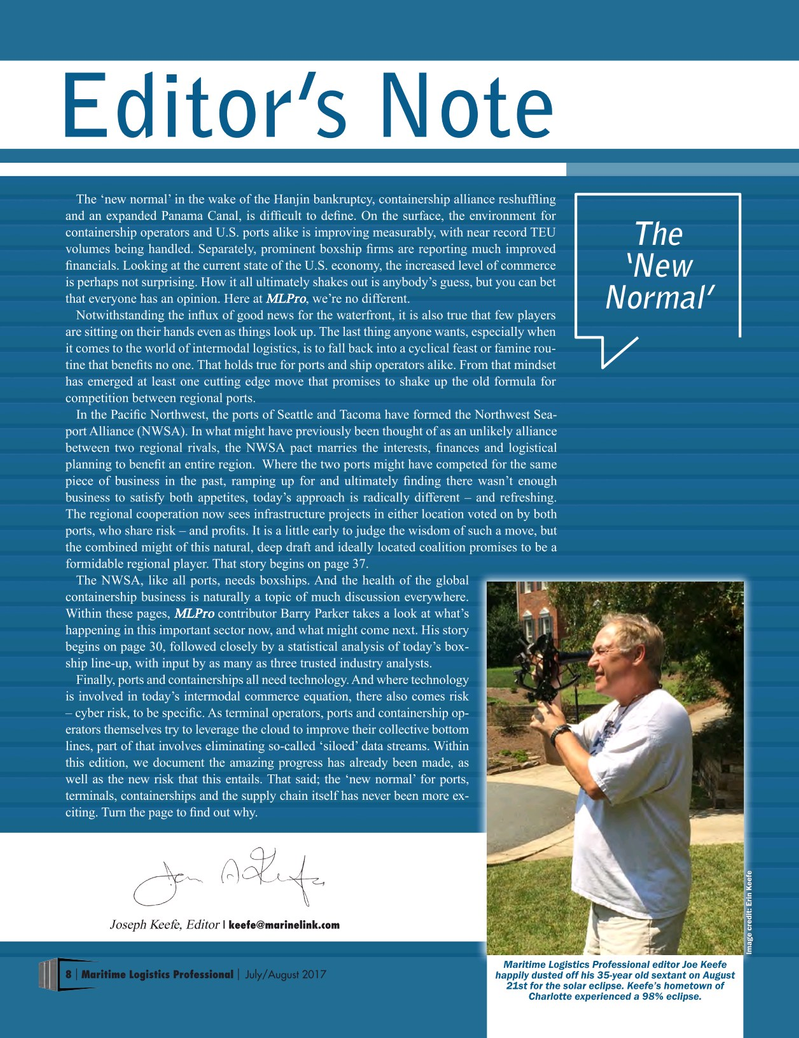
Page 8: of Maritime Logistics Professional Magazine (Jul/Aug 2017)
PORTS & INFRASTRUCTURE
Read this page in Pdf, Flash or Html5 edition of Jul/Aug 2017 Maritime Logistics Professional Magazine
Editor’s Note
The ‘new normal’ in the wake of the Hanjin bankruptcy, containership alliance reshuffing and an expanded Panama Canal, is diffcult to defne. On the surface, the environment for containership operators and U.S. ports alike is improving measurably, with near record TEU
The volumes being handled. Separately, prominent boxship frms are reporting much improved fnancials. Looking at the current state of the U.S. economy, the increased level of commerce ‘New is perhaps not surprising. How it all ultimately shakes out is anybody’s guess, but you can bet that everyone has an opinion. Here at MLPro, we’re no different.
Normal’
Notwithstanding the infux of good news for the waterfront, it is also true that few players are sitting on their hands even as things look up. The last thing anyone wants, especially when it comes to the world of intermodal logistics, is to fall back into a cyclical feast or famine rou- tine that benefts no one. That holds true for ports and ship operators alike. From that mindset has emerged at least one cutting edge move that promises to shake up the old formula for competition between regional ports.
In the Pacifc Northwest, the ports of Seattle and Tacoma have formed the Northwest Sea- port Alliance (NWSA). In what might have previously been thought of as an unlikely alliance between two regional rivals, the NWSA pact marries the interests, fnances and logistical planning to beneft an entire region. Where the two ports might have competed for the same piece of business in the past, ramping up for and ultimately fnding there wasn’t enough business to satisfy both appetites, today’s approach is radically different – and refreshing.
The regional cooperation now sees infrastructure projects in either location voted on by both ports, who share risk – and profts. It is a little early to judge the wisdom of such a move, but the combined might of this natural, deep draft and ideally located coalition promises to be a formidable regional player. That story begins on page 37.
The NWSA, like all ports, needs boxships. And the health of the global containership business is naturally a topic of much discussion everywhere.
Within these pages, MLPro contributor Barry Parker takes a look at what’s happening in this important sector now, and what might come next. His story begins on page 30, followed closely by a statistical analysis of today’s box- ship line-up, with input by as many as three trusted industry analysts.
Finally, ports and containerships all need technology. And where technology is involved in today’s intermodal commerce equation, there also comes risk – cyber risk, to be specifc. As terminal operators, ports and containership op- erators themselves try to leverage the cloud to improve their collective bottom lines, part of that involves eliminating so-called ‘siloed’ data streams. Within this edition, we document the amazing progress has already been made, as well as the new risk that this entails. That said; the ‘new normal’ for ports, terminals, containerships and the supply chain itself has never been more ex- citing. Turn the page to fnd out why.
Joseph Keefe, Editor | [email protected]
Image credit: Erin Keefe
Maritime Logistics Professional editor Joe Keefe 8 Maritime Logistics Professional July/August 2017 happily dusted off his 35-year old sextant on August | | 21st for the solar eclipse. Keefe’s hometown of
Charlotte experienced a 98% eclipse.

 7
7

 9
9
